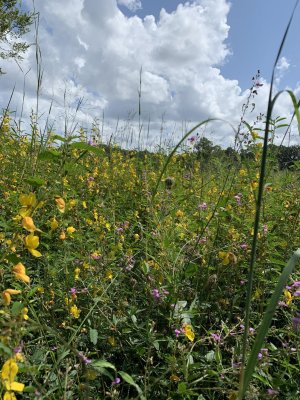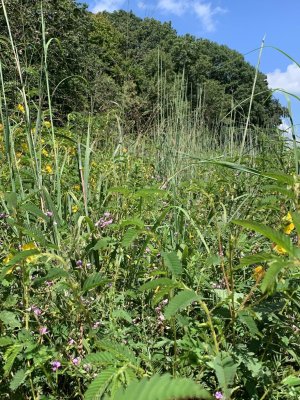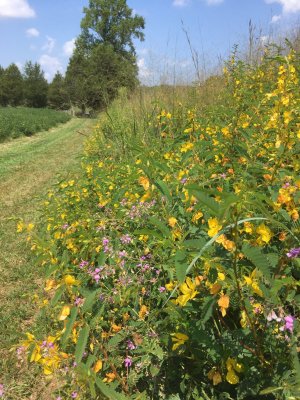Native Hunter
5 year old buck +
During the chase phase, does want to run in thick cover to help escape bucks. They had rather run through cover that doesn't poke their eyes out, which is why I think you see so many chases in NWSGs.
You are 100% right. I bow hunted only for deer from the age of about 45 to age 65. At age 45, I hadnt bought my land yet and was hunting mostly public and regularly shooting the first legal deer I saw. Also, since I was bow hunting, I was almost always hunting in woods where I couldnt see much over 50 yards. I hurt my shoulder when I was about 65 and started hunting with a crossbow - but also a lot with a rifle. Been a long time since I hunted with a rifle. I started hunting areas where I could see a lot farther. My favorite stand is an 8 acre food plot in a native pecan grove. I can see two hundred yards in several directions. We have a lot more deer now than we did twenty years ago when I last hunted with a gun. I have learned more about deer behavior in the last five years than I did in the previous twenty years - because I can see them a lot farther, a lot more of them, and them having no idea I am there. I see lots of fighting, a fair bit of breeding, bucks checking does and working the edge of the opening - on a regular basis - things I rarely saw bow hunting in the woods - I now see all the time. Rifle season is just an excuse to go. I have killed one deer in four years - but I could kill a legal deer every hunt. I have never hunted that pecan grove without seeing deer. You learn so much more watching sometimes 25 deer in a morning in an area they are visible - than seeing one or two in the woods. Sometimes I go sit at that pecan grove just to watch - with no weapon.Does that ever bring back memories! That water is like an alarm system, both from seeing the ripples and hearing their steps. You can hear them moving through it and coming your way or just out of sight. It's an awesome experience on a clear, still morning to hear that sploosh and see those ripples. The difference I've seen in old field/prairie/savannah type areas is the distance you can see them. You can learn a lot about deer behavior when you can watch them for long periods of time and they feel comfortable.
Was the you tube video that he is strongly suggesting sorgum/ Sudan grass over switch?I saw a YT video tonight that questioned the effectiveness of switch as a top choice bedding medium. Now, for context, let's say we're talking about the big woods, and not farm country that has one tree per 4 square miles. I will concede, where there is no cover in plowed field country, switch will likely do outstanding. But let's talk about other places.
What are the elements of a first class bedding location? I don't know for certain, but here's what comes to my mind:
*Complete visual seclusion
*Gives the deer a vantage point to see danger coming from downwind
*Multiple escape routes in the event of ambush
*Reliable winds enable scenting danger from behind
I wonder if there are really vantage points in tall switch, and multiple escape routes. Am I way out in left field on this?
I think it's generally thought nowadays that lighter populations / thinner stands are the most desirable end result. The best choices (RC, Kanlow, CIR) will stand just fine usually until repeated heavy winter snows lay them flat. Usually around here that's well past deer season's end. Seems guys have years of observations that deer prefer bedding in and travelling through thinner stands, plus forbs and diversity fill in better that way. That said, don't make it too sparse. Others can weigh in.Anyone ever intentionally or (accidentally) plant large stands at a lower seed rate to get diversity for feeding/bedding? How well does switch stand if it isn't dense enough?



Do you ever throw clover or rye in those lanes when mowing?Up north where snowfall is heavier, I think that pure switch might be the best choice due to winter standability. However, even though we have a few snows, our winters here are not that severe. Because of that, I like a heavy forb presence in my planting rather than straight grass. When you mow shooting lanes in the early fall, you will get some good forb regrowth before hunting season, and the tender new growth is a draw for deer.
View attachment 74178
View attachment 74179
View attachment 74180
Do you ever throw clover or rye in those lanes when mowing?
Any issues with fawns in there in the spring time? Bedding when you are trying mow?No, I think it would take some tilling for that to work. The already established grasses and forbs form a fairly thick mat and would keep the seed from reaching the ground and germinating.
Generally, in the afternoons the deer will filter out into the lanes and browse naturally occurring forbs as they work their way toward the plots.
Here is another thing to keep in mind - deer will also stand in the lanes and browse the un-mowed edges up high on the forbs. As I have heard Dr. Harper discuss, many forbs do not lose their palatability at the tips as they grow tall. Having a mowed lane just makes it easier for them to see what they are doing when they browse the tips higher on the plant.
When I mow lanes, I just want to get it over and get out as quickly as I can - because I cringe when I see all of the beds and hope I'm not disturbing things too bad. That's why I mow fairly early - I want to have plenty of time for things to settle back down before hunting season and before bucks start their fall transitioning.
Any issues with fawns in there in the spring time? Bedding when you are trying mow?
How do you keep it that open. My nwsg becomes a solid stand very quickly. When I first got the place and was killing the pasture grasses and the forbs were the first to come in - deer were in the field everyday feeding. Within three or four years, it was pure stands of nwsg - and the only deer you see are walking through it to get to the other side. They are much more likely to bed in a pure wheat field than nwsg.Here is a native grass area right now (at a mineral site). I like about this amount of open ground beneath the grass.
View attachment 74182
I have about 8 acres of CRP that I planted with a blend that included switchgrass. I just used a broadcast spreader, so the seeding mixture varied depending on how well or poorly I mixed the seed before putting it in the spreader. I'm pretty happy with how it turned out and I'd estimate that about 1/3 of the grasses growing are switchgrass. The best looking areas in that field are the random patches in the fields that I somehow missed while planting. These little pockets filled in with weeds, which get quite a bit of use when they are surrounded by the switchgrass mix.Anyone ever intentionally or (accidentally) plant large stands at a lower seed rate to get diversity for feeding/bedding? How well does switch stand if it isn't dense enough?
I don't know how Omicron keeps his ground open like that, but I have some crp ground that looks like that in a couple of small sections. It is the worst sandy soil that struggles to retain any moisture. The same seed blend planted 30 yards away in great soil grows plants that are much taller and thicker, with no soil visible.How do you keep it that open. My nwsg becomes a solid stand very quickly. When I first got the place and was killing the pasture grasses and the forbs were the first to come in - deer were in the field everyday feeding. Within three or four years, it was pure stands of nwsg - and the only deer you see are walking through it to get to the other side. They are much more likely to bed in a pure wheat field than nwsg.
I sprayed cleth on about two acres - it thinned it - but still no open ground. I killed everything on another couple acres. Not positive what I am going to do with that yet - but probably a light seeding of millets and milo and hope some forbs come in. Another five acres of nwsg - I killed out with several sprayings of cleth and spread pollinator seeds. I am hoping to see some forb growth in there this year. I am going to keep it sprayed with cleth until the pollinator plants get going. My fields are pretty high maintenance.
I plant it at very low rates. I also planted with Milo at time of planting which helps.How do you keep it that open. My nwsg becomes a solid stand very quickly. When I first got the place and was killing the pasture grasses and the forbs were the first to come in - deer were in the field everyday feeding. Within three or four years, it was pure stands of nwsg - and the only deer you see are walking through it to get to the other side. They are much more likely to bed in a pure wheat field than nwsg.
I sprayed cleth on about two acres - it thinned it - but still no open ground. I killed everything on another couple acres. Not positive what I am going to do with that yet - but probably a light seeding of millets and milo and hope some forbs come in. Another five acres of nwsg - I killed out with several sprayings of cleth and spread pollinator seeds. I am hoping to see some forb growth in there this year. I am going to keep it sprayed with cleth until the pollinator plants get going. My fields are pretty high maintenance.
